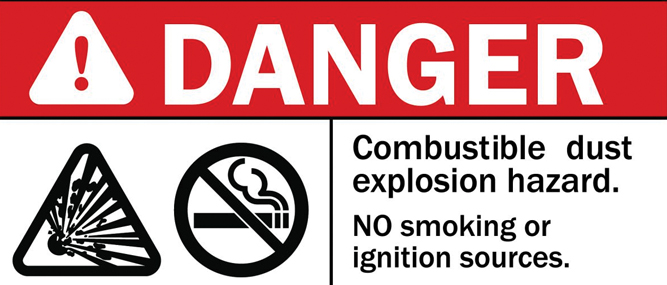Should pallet manufacturers, sawmills and other wood processers be concerned about combustible dust? You should at least be aware of the issue. What actions you take and how much of a safety focus it should be depends on your specific facility and processes.
Do you manufacturer wood dust? As soon as a saw blade, belt or cutting head touches the wood, the composition of the wood changes and wood dust is created in one form or another. Everything from large chips to fine wood flour is created. However, is the wood dust you manufacture combustible? The reality is that isn’t an easy question to answer without an analysis of your production environment.
The Occupational Safety & Health Administration (OSHA) currently does not have a combustible dust regulation. However, OSHA has been exploring the possibility of a regulation since 2009. As recent as 2013, OSHA continues to address combustible dust by incorporating it into the updated Hazard Communication Standard. In this emphasis area, OSHA lists combustible dust as a “hazardous chemical.”
What is Combustible Dust?
According to OSHA, combustible dusts “are fine particles that present an explosion hazard when suspended in air under certain conditions.” “Certain conditions” refer to two key parameters – dispersion and confinement. Dispersion means the dust particles are suspended in air. Confinement means the dust is in an enclosed or limited space. This restriction allows pressure to build up, increasing the likelihood of an explosion.
A potentially combustible fine wood particle is additionally defined by particle size, shape, age, moisture connect, as well as other factors. If there is any doubt of combustibility, the dust must be sent to a certified facility to be tested. NFPA 652 (2015) states “To determine if the dust can present an explosion hazard, the simplest test that can be performed is known as the “go/no/go” test “yes, it blows up, or no, it doesn’t” according to ASTM E 1226 Standard Test Method for Explosibility of Dust Clouds. Additional tests include (MIE) Minimum Ignition Energy test ASTM E-2019, and Explosion Severity Test (KSt and PMAX) ASTM E-1226. Testing price ranges from approximately $350-$1,300 up to $3,850 for a full OSHA NEP Package.
Key Standards Organizations to Consult
There are various organizations that provide guidance in combustible dust including OSHA, the National Fire Protection Association and FM Global. Also any government or code enforcement officer who has jurisdiction over your area may have authority over your decision process.
NFPA (National Fire Protection Association) is an “International Codes and Standards Organization” that creates voluntary consensus standards. According to OSHA, “These standards are NOT OSHA regulations. However, they do provide guidance from their originating organizations related to worker protection. In some cases, they may be mandated by state or local governments, or individual companies.”
Several relevant NFPA standards related to Combustible Dust, a few relevant to wood industries include but are not limited to: NFPA 69 Standard on Explosion Prevention Systems; NFPA 654 Standard for the Prevention of Fire and Dust Explosions from the Manufacturing, Processing, and Handling of Combustible Particulate Solids; NFPA 664 Standard for the Prevention of Fires and Explosions on Wood Processing and Woodworking Facilities; and NFPA 652 Standard on Combustible Dusts, scheduled to be released in 2015. The NFPA 652 Standard shall be applied to all facilities where combustible dusts or particulate solids are present.
And FM Global offers a data sheet titled, “7-76 Prevention and Mitigation of Combustible Dust.” This data sheet describes recommended preventive measures to reduce the frequency of combustible dust explosions, and protection features to minimize damage from a combustible dust explosion.
Simple Housekeeping Is Your First Step
While learning the best practices explained above are great, the first step is something you can do right now. And that is simple housekeeping to remove collected wood dust and prevent it from becoming an issue in the future.
If you can see dust, don’t ignore it. Underlying surface colors that are NOT readily discernible warrants immediate cleaning of area. Flat surfaces are not good, as they are collection zones for fugitive dust. Ensure areas such as rectangular HVAC ducting, overhead beams, electrical cable trays, and areas above suspended ceilings are all inspected for fugitive dust as part of housekeeping. Finally, by addressing the source(s) of the dust and properly eliminating the leak will prevent additional buildup of fugitive dust. Having a proper functioning dust collection system, with explosion venting and or suppression, as well as spark detection where required, will also help to mitigate any potential issues.
Worker training is very important. Have workers been trained and do they understand the hazards of
combustible dust? Explosions can be prevented. In one situation, employees were trying to unclog a metal dust collector with a metal rod, which upon contact created a spark, creating an explosion. “Safe work habits are developed and do not occur naturally.” NFPA 652 (A.8.4.2.1). NPFA is addressing worker training in NFPA 652 which will be a valuable resource once released this year.
So, if you manufacture combustible dust you need to be aware of the situation and determine the severity to your staff and facility. While there is currently no specific Combustible Dust regulation by OSHA there are a number of resources available and worthy of additional study. The best play is to recognize the real danger posed by combustible dust and to make this a safety priority.
Editor’s Note: Jamison Scott serves as executive vice president of Air Handling Systems, a family-owned business in Woodbridge, Connecticut. He is an expert on combustible dust and technologies that can help address it. For more information on this topic, contact Jamison Scott at 203-389-9595, extension 105 or email jscott@airhand.com.




